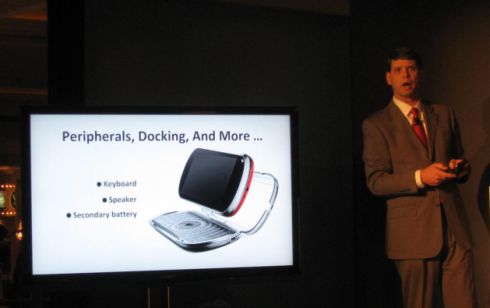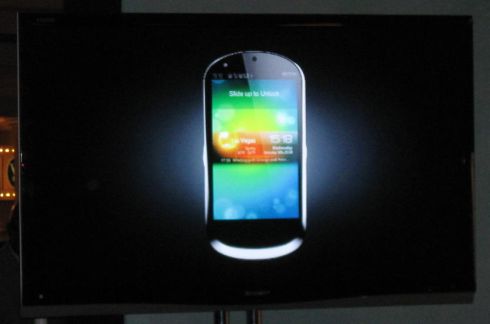
Lenovo is pushing its Mobile Internet strategy hard at CES. We already saw the company’s new line of mobile PCs including the Skylight smartbook, IdeaPad S10-3t tablet, S10-3 netbook and IdeaPad U1 Hybrid laptop/tablet. But the company is also launching its first smartphone, which it’s calling the LePhone.
Now, I don’t tend to cover smartphones very often because I prefer devices with full keyboards, larger displays, and the ability to be useful even when you’re not online. But the Lenovo LePhone comes pretty close to meeting those requirements thanks to an optional docking accessory that has a QWERTY keyboard, an extra battery, and built-in speakers.
At the Lenovo press conference this afternoon, officials also explained that the company’s mobile strategy will roll out first in China, where Lenovo has a huge presence. It’s also an emerging market with a growing number of mobile broadband users. The LePhone should be available in China in the first or second quarter of 2010. It will run Android with Lenovo’s custom user interface on top. It has a user replaceable battery, a 3.7 inch 480 x 800 pixel touchscreen display, and no buttons on the front.
It’ll sport a 1GHz Qualcomm Snapdragon CPU, which is the same platform powering the Skylight smartbook. It will have two cameras, one facing the front and the other will be on the back. ANd there’s a button you can squeeze on the side of the phone to activate gesture support. For instance, you can move the phone to the left or right to navigate through Google Maps.
At times, I got the sense that Lenovo was starting to worry that just as the growth areas in the computer industry have moved from desktops to laptops in recent years, the next big push is going to be in the smartphone space and that Lenovo is introducing products like the Skylight and LePhone simply because it doesn’t want to be left out.
But what is continually left out of this conversation is discussion of the ongoing price of these products. While wireless carriers tend to subsidize this type of device, making the up front costs negligible, if you have to pay $30/month for a data plan on your phone and $60/month more for a data plan on your smartbook, I just don’t see these going anywhere. On the other hand, that’s the going rate for mobile broadband in the US… things may be different in China. And I’m hopeful that one day you’ll be able to add a smartbook to your existing wireless data plan for $10 or $20 more than your cellphone plan rather than doubling the cost. But that may just be because I’m a dreamer. I have absolutely no evidence that any carrier plans to offer that kind of pricing.
You can find a few more photos from the Lenovo event after the break.












Back when the iphone was first announced, I thought no one would buy it, because it would require an added $40/mo smartphone data plan. AT&T ended up charging less than I expected (and less than they were charging other smartphone users), but in any case, people proved willing to spend more than I expected.
It never makes sense to me, but people have consistently beaten my expectations for what will be considered an acceptable monthly charge. It won’t surprise me anymore if people start ponying up for insane smartbook data fees (though the plus for me is that as they do, the price will go down some).
Of course, not all “6,292,030,277 billion” of them…. 😉
People in the US are spoilt and rely heavily on carriers subsidizing their phones or netbooks.
I got news for you. US is not the only place in the world. It only has
304,059,724 million people.
Whatever trend follows or whatever product succeeds depend on whether people are willing to buy the full price of the product.
And this depends on the 6,292,030,277 billion people ie the rest of the world who pay the full price of any product